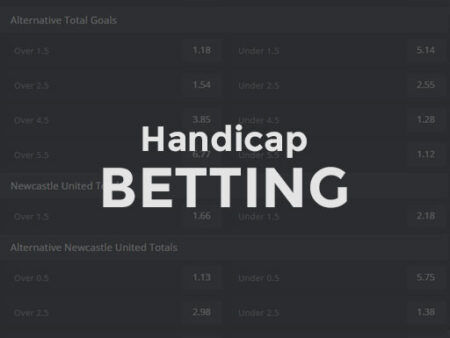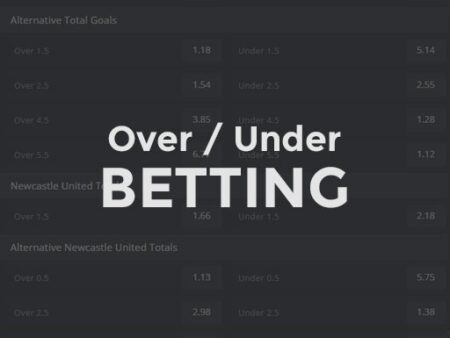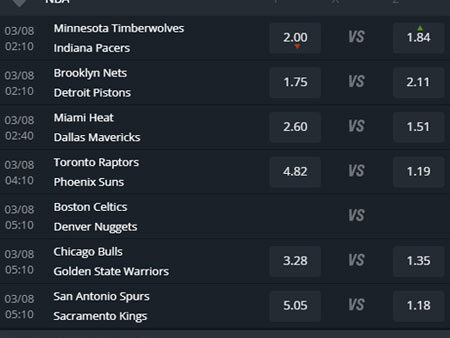Learning how to read sports betting odds can seem like deciphering a secret code to newcomers.
With terms like “American odds,” “fractional odds,” and “decimal odds” thrown into the mix, it’s easy to feel lost.
This guide is your key to unlocking sports betting odds mastery.
Understanding these numbers isn’t just about making bets; it’s about making informed decisions that increase your chances of winning.
Let’s break down the complexities of betting odds into simple, easy-to-grasp concepts, ensuring you step into the betting arena with confidence.
Key Takeaways:
- Sports Betting Odds Formats: Learn the differences between American, fractional, and decimal odds, and how each format represents the potential winnings and risks involved in a bet.
- Calculating Winnings: A step-by-step guide on how to calculate your potential winnings across different odds formats, enabling you to understand the value of your bets at a glance.
- Understanding Implied Probability: Discover how odds can be converted into a break-even percentage, offering insight into the likelihood of an event occurring according to the bookmakers.
- Making Informed Bets: Equip yourself with the knowledge to interpret betting odds, allowing you to place wagers not just based on gut feeling, but on calculated decisions.
Sports Betting Odds Simplified
Betting odds are a fundamental aspect of sports betting, serving as a cornerstone for both bookmakers and bettors.
They indicate the likelihood of an event’s outcome and determine the potential return on a bet. Understanding these odds is crucial because they not only reflect the chance of a particular result but also include the bookmaker’s margin.
Essentially, they guide bettors in making informed decisions by evaluating the risk versus the reward.
Overview of American, Fractional, and Decimal Odds:
American Odds
These are primarily used in the United States and are represented with a plus (+) or minus (-) sign. The plus sign indicates how much a $100 bet will win if betting on an underdog, while the minus sign shows how much you need to bet to win $100 on the favorite.
Let’s take as an example the NBA match between Miami Heat (+160) and Dallas Mavericks (-196) and the moneyline for this event to see what’s the math behind.
If you bet on Miami $100, your total return will be $260 ($160 profit). If you instead want to go with the favorite, Dallas, in order to get a profit of $100 you will need to wager $196.
If you bet $50 on Dallas you will need to solve this in order to get the profit:
Odds/100 = wager/x , X = winnings-> in this case 196/100 = 50/x -> x = 50*100/196 -> x = $25.51
Fractional Odds
Common in the UK, these odds are presented as a fraction, such as 5/1 (five-to-one). This means for every $1 wagered, you win $5 if your bet is successful. They are straightforward in showing the profit relative to the stake.
We will use the same example, and in this case Miami has 8/5 and Dallas 51/100.
If you make the same bets, of course the profits will be the same.
In order to calculate your profit for the fractional odds you will need to use this formula:
winnings = wager*odds -> $50 * (51/100)= $50 * 0.51 = $25.50 (same example with $50 bet on Dallas)
Decimal Odds
Widely used outside the United States, decimal odds show the total amount returned for a $1 bet, including the original stake. For example, odds of 3.00 mean you receive $3 back for every $1 bet if you win, which includes your $1 stake.
We will use yet again that example and Miami has 2.60 odds, while Dallas has 1.51.
In order to calculate the winnings use this formula:
winnings = (wager * odds) – wager -> winnings = ($50 * 1.51) – $50 = $75.5 – $50 = $25.50
How Do Betting Odds Work?
Betting odds are a numerical expression of the likelihood of a specific outcome in a sports event.
They are used by bookmakers to show the potential return on a bet relative to the stake. The odds reflect the probability of a certain result happening; the lower the odds, the higher the probability of that outcome, and vice versa.
Calculating Betting Odds
Calculating betting odds involves understanding the three main formats used by bookmakers: American, Decimal, and Fractional. Each format presents the odds differently but ultimately conveys the same information – the probability of an outcome and the potential return.
American Odds are represented with a plus or minus sign. A minus sign indicates how much you need to bet to win $100, while a plus sign shows how much you win if you bet $100.
Decimal Odds represent the total return (stake included) for a $1 bet. To calculate your total return, you multiply your stake by the decimal odds.
Fractional Odds show the profit relative to the stake, expressed as a fraction. The total return is calculated by multiplying the stake by the fraction plus the original stake.
What is Vigorish: How Does It Affect Sports Betting Odds?
Vigorish, also known as the “vig” or the “juice,” is the fee a bookmaker charges for taking a bet. It’s essentially how sportsbooks make money.
The vig is built into the odds, affecting the potential payout.
For example, in an even match, instead of offering even odds (2.00 in decimal, +100 in American, or 1/1 in fractional), a bookmaker might offer 1.91 (or -110 in American odds), meaning you’d need to bet $110 to win $100. This $10 difference represents the vig, ensuring the bookmaker profits regardless of the outcome
American Odds Explained
American odds, or moneyline odds, are all about the $100 benchmark.
For favorites (indicated by a minus sign), it’s about how much you have to bet to win $100.
For underdogs (indicated by a plus sign), it’s about how much you win if you bet $100.
For instance, if the New York Yankees are -150 against the Boston Red Sox, you’d need to bet $150 on the Yankees to win $100. Conversely, if the Red Sox are +130, a $100 bet would net you $130 if they win.
How to Interpret Positive (+) and Negative (-) American Odds:
- Positive Odds (+): Represent underdogs. The number indicates how much you’d win from a $100 bet. For example, +200 means winning $200 on a $100 bet.
- Negative Odds (-): Indicate favorites. The number tells you how much you need to bet to win $100. For example, -150 means you need to bet $150 to win $100.
How to Convert American Odds to Different Formats
Converting American Odds to Decimal:
- For positive American odds (+), the formula is (American odds / 100) + 1.
- For negative American odds (-), the formula is (100 / Absolute value of American odds) + 1.
Converting American Odds to Fractional:
- For positive American odds (+), convert the odds to a fraction (e.g., +300 becomes 300/100) and then simplify.
- For negative American odds (-), use the formula 100 / Absolute value of American odds to create a fraction, which you then simplify.
Example:
+300 American Odds to Decimal: (300 / 100) + 1 = 4.00
+300 American Odds to Fractional: 300/100 simplifies to 3/1.
-150 American Odds to Decimal: (100 / 150) + 1 = 1.67
-150 American Odds to Fractional: 100/150 simplifies to 2/3 after inverting the fraction to represent how much you need to bet to win $100.
Fractional Odds Demystified
Fractional odds are the ratio of profit to stake. If you see odds of 4/1, this means you win $4 for every $1 bet (plus your original stake back) if your bet wins. Conversely, 1/4 odds mean you win $1 for every $4 bet, which typically signifies a heavy favorite.
Calculating Potential Returns from Fractional Odds
To calculate your potential return from fractional odds, multiply your stake by the fraction.
For a $10 bet at 5/1 odds, your potential profit is $10 * (5/1) = $50, plus your $10 stake back, for a total of $60. For odds of 1/5, a $10 bet would yield $2 profit (10 * 1/5), plus your original stake, totaling $12.
Decimal Odds: Simplifying the Complex
Decimal odds offer a straightforward approach to understanding betting odds, significantly simplifying the betting process for both novices and experienced bettors alike.
Unlike American or fractional odds, decimal odds represent the total amount you stand to receive for every dollar wagered, including your original stake.
This means that if the decimal odds are listed at 3.00, a successful $1 bet would return $3 in total – $2 profit plus the original $1 stake.
Practical Examples of Decimal Odds
Consider a soccer match between Team A and Team B, with decimal odds of 1.50 for Team A and 2.50 for Team B. A $100 bet on Team A, if successful, would return $150 ($50 profit plus the original $100 stake), indicating that Team A is the favorite.
Conversely, the same bet on Team B would yield $250 ($150 profit plus the original $100 stake), showing Team B as the underdog with a higher reward due to a perceived lower chance of winning.
Advantages of Using Decimal Odds for Betting:
- Clarity: Decimal odds provide clear and immediate understanding of potential returns, without the need to calculate how much profit will be made on top of the returned stake.
- Ease of Use: Calculating total returns is straightforward—simply multiply the stake by the decimal odds. This simplicity makes comparing odds across different events or outcomes much easier.
- Universal Application: Decimal odds are used worldwide, making them a universal tool for comparing odds across international sportsbooks.
Converting Odds to Break-Even Percentages
Understanding the implied probability behind betting odds is crucial for making informed betting decisions.
Implied probability is the conversion of betting odds into a percentage that reflects the likelihood of an event occurring according to the odds offered by the bookmaker.
The Concept of Implied Probability
Implied probability can be seen as the bookmaker’s estimation of an event’s chances of happening. It’s important for bettors because it helps identify value bets—situations where the bettor believes the probability of an event occurring is greater than what the odds suggest.
How to Convert Odds to Break-Even Percentages
- American Odds: Positive odds are converted using the formula 100 / (American odds + 100) * 100. For negative odds, the formula is -American odds / (-American odds + 100) * 100.
- Fractional Odds: The formula is denominator / (denominator + numerator) * 100. For example, odds of 1/4 convert to an implied probability of 80%.
- Decimal Odds: The formula for converting decimal odds to implied probability is 1 / decimal odds * 100. For instance, odds of 2.00 imply a 50% chance of winning.
Wrapping Up: Our Final Recommendations
By now, it’s clear that a solid understanding of how to read sports odds work serves as the foundation for any successful betting strategy.
Whether you’re a novice bettor just starting out or a seasoned gambler, grasping the nuances of different odds formats and the concept of vigorish can significantly enhance your betting experience.
From an expert’s perspective, the ability to calculate and convert odds across formats is not just a skill but a critical tool in your betting arsenal. It enables you to compare odds across various bookmakers efficiently, ensuring you always get the best value for your bets. Furthermore, understanding the impact of vigorish on your potential winnings allows for a more accurate assessment of the true value offered by a bet, guiding you towards more profitable decisions.
Remember, betting is not just about luck but informed decision-making.
By applying the knowledge of how odds work, including the calculations and conversions discussed, you’re not only placing bets but strategically investing in outcomes based on calculated probabilities.
Moreover, embracing the mathematical aspect of betting through odds conversion and understanding vigorish emphasizes the importance of discipline and a systematic approach to betting. It’s these qualities that often differentiate successful bettors from the rest.
As you continue on your betting journey, keep refining your skills in reading and interpreting odds.
Stay informed about the sports you bet on, and never stop looking for an edge that can tilt the odds in your favor. Betting, at its core, is a blend of knowledge, strategy, and intuition.
With a solid grasp of betting odds as your foundation, you’re well-equipped to navigate the thrilling world of sports betting with confidence and success.













